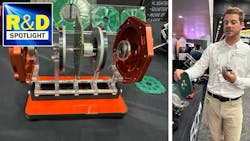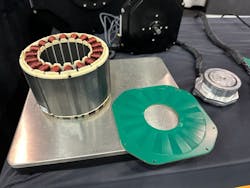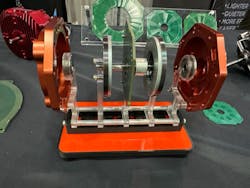R&D Spotlight: PCB Stator Technology Replaces Bulky Copper Windings
If the folks at ECM PCB Stator Technology have their say, applications for printed circuit board (PCB) stator motors will replace the bulky copper windings associated with electric motors.
The Massachusetts-based start-up has developed a printed board stator that’s smaller than the average motor, achieves efficiencies as high as 96% and requires up to 70% less raw materials to produce.
“We’ve essentially innovated in the electric motor space,” said Ethan Frick, director, New Business Development, ECM PCB Stator Technology. “For about 100 years, electric motors have evolved into these extremely bulky copper wire stators. It is the interaction of the copper and the magnets that creates the torque and speed. You need that copper, but it’s extremely inefficient to wind it like this. It requires a significant amount of machining tools and design time.”
The company also developed a complementary software platform for designing purpose-built PCB stator motors suited to a variety of applications, such as robotics, medical devices or autonomous vehicles. PrintStator enables engineers to rapidly design, model and prototype optimized printed-circuit-board stator motors to exact specifications, said Jake Bright, director of Communications and Investor Relations, ECM PCB Stator Technology.
The start-up recently reported that it was granted additional IP and patents for its use of printed circuit board stators for advanced performance of axial flux, air core machines.
Asked to sum up the design and unique features of the PCB stator, Frick said, “What we’ve done is replace the entire [winding] structure with a printed circuit board (PCB). And these printed circuit boards are constructed the same way as circuit boards found in your phone and laptop board.
“We’re essentially able to utilize all those existing manufacturing and design tools that are out there to create our motors,” he continued. “And we end up with this extremely simple axial flux motor, where you have our copper piece stator in the middle, magnets on either side—and that’s all you need.”
The only potentially complex thing about this type of motor, said Frick, is the design scheme that goes into these PCB stators. But ECM Chief Scientist Steven Shaw, who received his PhD from the Massachusetts Institute of Technology, came up with a software that automates the design of these motors.
“From robotics to fans to medical pumps and robotic surgery, we’re able to plug in torque and speed and voltage, and it will spit out not only a datasheet that gives us build, cost and performance data, but also give us operating conditions under many environments,” said Frick. “The data is packaged into a design file, which we can instantly send to that same PCB house that makes your phone PCBs, to print the same day.”
Frick further pointed out that a disconnect exists between the innovation in electrification and electric motors and engineers often use the wrong motors in their applications. He added that ECM has the capability to design custom electric machines through its PCB stator technology and the company’s software optimization platform, PrintStator.
“You come to us and tell us exactly what you need for your underwater submarine propulsion motor, or your exoskeleton shoulder actuator, or your blender motor, and we’re going to design something with inherent advantages, a PCB stator that is smaller and lighter,” Frick said. “But they’re also going to be highly specialized.”
RELATED
Automate 2023 Welcomes Economical, Flexible Automation Solutions
Look Who’s Talking: Automate 2023 Keynotes, Topics and Quick Links
About the Author

Rehana Begg
Editor-in-Chief, Machine Design
As Machine Design’s content lead, Rehana Begg is tasked with elevating the voice of the design and multi-disciplinary engineer in the face of digital transformation and engineering innovation. Begg has more than 24 years of editorial experience and has spent the past decade in the trenches of industrial manufacturing, focusing on new technologies, manufacturing innovation and business. Her B2B career has taken her from corporate boardrooms to plant floors and underground mining stopes, covering everything from automation & IIoT, robotics, mechanical design and additive manufacturing to plant operations, maintenance, reliability and continuous improvement. Begg holds an MBA, a Master of Journalism degree, and a BA (Hons.) in Political Science. She is committed to lifelong learning and feeds her passion for innovation in publishing, transparent science and clear communication by attending relevant conferences and seminars/workshops.
Follow Rehana Begg via the following social media handles:
X: @rehanabegg
LinkedIn: @rehanabegg and @MachineDesign



